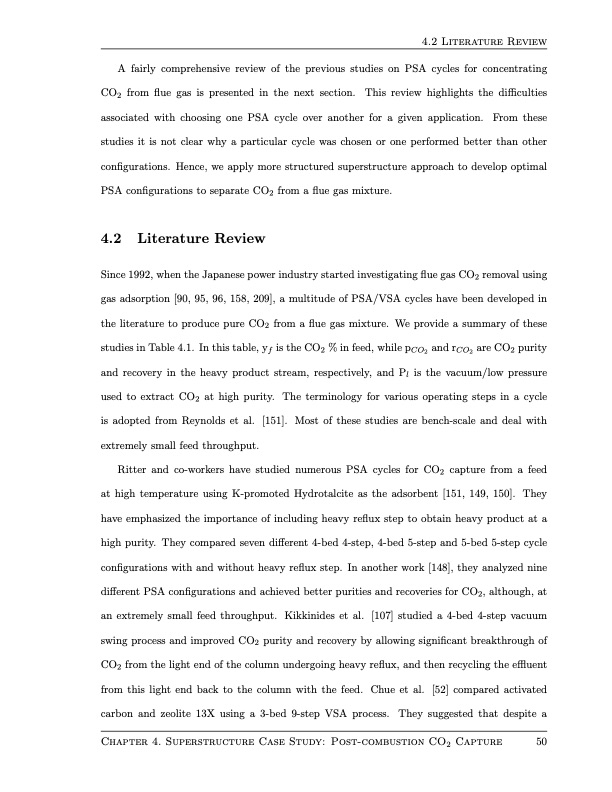
PDF Publication Title:
Text from PDF Page: 064
A fairly comprehensive review of the previous studies on PSA cycles for concentrating CO2 from flue gas is presented in the next section. This review highlights the difficulties associated with choosing one PSA cycle over another for a given application. From these studies it is not clear why a particular cycle was chosen or one performed better than other configurations. Hence, we apply more structured superstructure approach to develop optimal PSA configurations to separate CO2 from a flue gas mixture. 4.2 Literature Review Since 1992, when the Japanese power industry started investigating flue gas CO2 removal using gas adsorption [90, 95, 96, 158, 209], a multitude of PSA/VSA cycles have been developed in the literature to produce pure CO2 from a flue gas mixture. We provide a summary of these studies in Table 4.1. In this table, yf is the CO2 % in feed, while pCO2 and rCO2 are CO2 purity and recovery in the heavy product stream, respectively, and Pl is the vacuum/low pressure used to extract CO2 at high purity. The terminology for various operating steps in a cycle is adopted from Reynolds et al. [151]. Most of these studies are bench-scale and deal with extremely small feed throughput. Ritter and co-workers have studied numerous PSA cycles for CO2 capture from a feed at high temperature using K-promoted Hydrotalcite as the adsorbent [151, 149, 150]. They have emphasized the importance of including heavy reflux step to obtain heavy product at a high purity. They compared seven different 4-bed 4-step, 4-bed 5-step and 5-bed 5-step cycle configurations with and without heavy reflux step. In another work [148], they analyzed nine different PSA configurations and achieved better purities and recoveries for CO2, although, at an extremely small feed throughput. Kikkinides et al. [107] studied a 4-bed 4-step vacuum swing process and improved CO2 purity and recovery by allowing significant breakthrough of CO2 from the light end of the column undergoing heavy reflux, and then recycling the effluent from this light end back to the column with the feed. Chue et al. [52] compared activated carbon and zeolite 13X using a 3-bed 9-step VSA process. They suggested that despite a 4.2 Literature Review Chapter 4. Superstructure Case Study: Post-combustion CO2 Capture 50PDF Image | Design and Operation of Pressure Swing Adsorption Processes

PDF Search Title:
Design and Operation of Pressure Swing Adsorption ProcessesOriginal File Name Searched:
anshul_thesis.pdfDIY PDF Search: Google It | Yahoo | Bing
CO2 Organic Rankine Cycle Experimenter Platform The supercritical CO2 phase change system is both a heat pump and organic rankine cycle which can be used for those purposes and as a supercritical extractor for advanced subcritical and supercritical extraction technology. Uses include producing nanoparticles, precious metal CO2 extraction, lithium battery recycling, and other applications... More Info
Heat Pumps CO2 ORC Heat Pump System Platform More Info
| CONTACT TEL: 608-238-6001 Email: greg@infinityturbine.com | RSS | AMP |